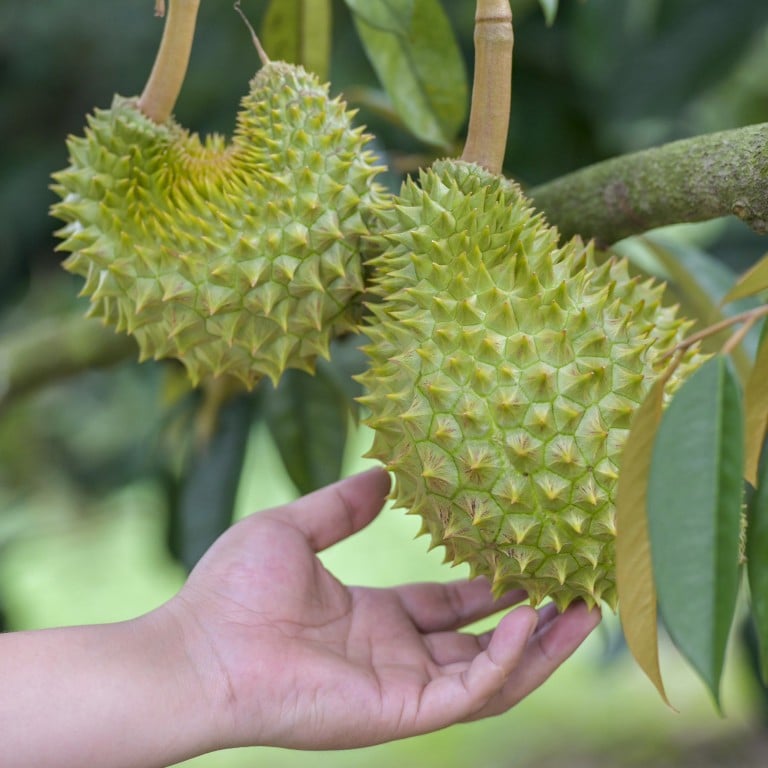
Want to try China’s first domestically grown durian? Better head to Hainan, or wait a few years
- Only about 50 tonnes of durian are now expected from the Chinese province this year – far less than earlier estimates and nowhere close to the roughly 1 million tonnes that China will consume in 2023
- Hainan will vastly expand planting acreage in the coming years to meet surging durian demand, bring down prices
China’s home-grown durian is finally expected to hit the market this month, but it could be years before the vast majority of consumers can get their hands on it, and estimates for projected yields have fallen sharply in recent months, according to an expert on tropical fruits.
In the tropical island province of Hainan, farmers are gearing up for the nation’s first large-scale domestic durian harvest after more than four years of cultivation. They are keen to cash in on the growing domestic demand for what has quickly become China’s most popular imported fruit – one that is native to Southeast Asia and known for its uniquely potent smell.
But Feng Xuejie, director of the Institute of Tropical Fruit Trees at the Hainan Academy of Agricultural Sciences and a researcher at the Hainan Academy of Agricultural Sciences, expects that Hainan will only produce around 50 tonnes (110,000 pounds) of durian this year, according to a report by state broadcaster CCTV on Saturday. That would account for only about 0.005 per cent of all the durian eaten in China this year.
Last month, Feng was quoted by the Red Star News media outlet as saying that the March figure had been “overestimated”, as “there is no large area of fruit-bearing yet”.
“Some durian plots are blooming, some plots are not blooming,” he said in May.
China to eat first local durians in June. Is Malaysian, Thai dominance at risk?
Therefore, it could take a few years for Hainan to be able to produce enough durian to sufficiently bring down domestic prices, Feng said. And what is grown there in the meantime will not be very cheap, as the nascent crops are costlier to produce than in Southeast Asian countries.
CCTV had also reported in March that durian plantations spanned nearly 700 hectares (1,700 acres) in Sanya, the southernmost city on Hainan island. But Feng said in May that “the total area of flowering plots in the province” is only about 70 hectares.
And while Feng now expects those numbers to see huge improvements in three to five years, domestic prices might not be affected until the overall plantation area surpasses 20,000-30,000 hectares.
The durians harvested this month will be allocated for potential customers in Hainan to develop the market, and the rest will probably be consumed by local tourists, Feng added on Saturday. So, consumers in the rest of the country might not be able to purchase them even when they become available.
“China’s independent plant-breeding system is being established, and it’s striving to cultivate durian varieties with independent intellectual property rights to support industrial development,” Feng said.
China is betting that its home-grown crop will help reduce domestic prices, capitalise on rising consumption of the fruit, and boost the nation’s international agricultural trade. But the key to the success of domestic durian is whether consumers find it palatable when compared with imports from Southeast Asia.
Prices of the tropical fruit have surged significantly in China, and it often sells out quickly at markets.
How China’s durian demand could leave bitter taste for some Asian countries
In the first quarter of this year, Vietnam exported US$153 million worth of durians – 7.3 times more than a year prior. And China accounted for 87 per cent of that total, according to data from the Ministry of Commerce.
Consumers can currently expect to pay around 349 yuan (US$50) for 7kg (15lbs) of durian from Vietnam on e-commerce site JD.com, and orders must be placed in advance. Durians from Thailand and Malaysia are currently sold out on the Tmall supermarket, the online shopping platform operated by Taobao.
Other countries are also tapping into China’s growing appetite for durian.
The country’s first durian shipment, totalling 28 tonnes, arrived in China on April 6, according to the Department of Agriculture of the Philippines.


